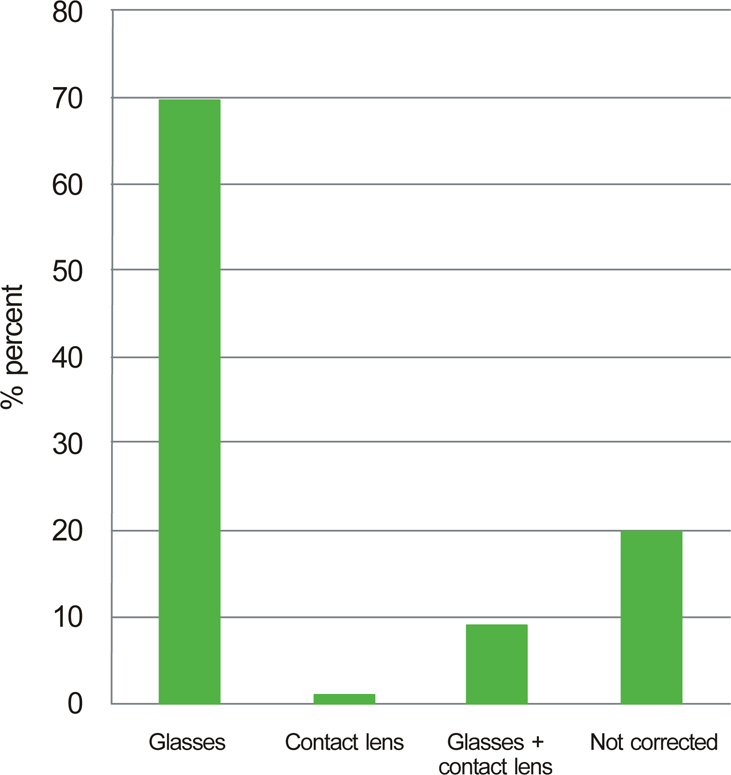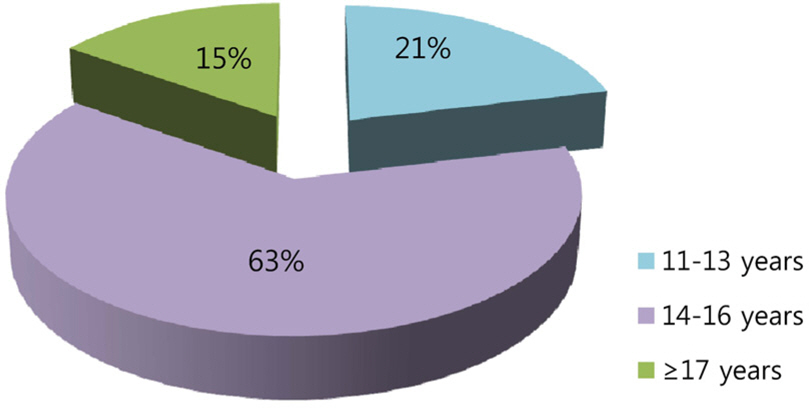J Korean Ophthalmol Soc.
2014 Jan;55(1):54-58.
A Survey on Contact Lens Care in Young Adolescent Student
- Affiliations
-
- 1Department of Ophthalmology, Wonkwang University School of Medicine, Iksan, Korea. cuchoi77@hanmail.net
Abstract
- PURPOSE
The present study was conducted to gather valid data for promoting public eye health among adolescent contact lens wearers by investigating the current practices of contact lenses wearers.
METHODS
A questionnaire regarding use and care of contact lenses was distributed to middle and high school students. A total of 920 students (472 males, 448 females) were enrolled and the purpose of the study was explained to the students.
RESULTS
Among all student, 49% had myopia (male 44%, female 54%) and 12% hyperopia (male 12%, female 13%). In addition, 70% of the subjects chose to wear glasses for vision correction, 27% (male 4%, female 50%) reported they have worn contact lenses and 64% of those were soft contact lenses. The age for starting contact lenses was between 14-16 years of age (63%). Most students (95%) purchased their contact lenses from an optical store. Many (89%) cleaned the contact lenses with cleaning solution on a daily basis, however, only 25% of the students received instructions on how to clean the lens properly. Common complaints associated with use in descending order were hyperemia (31%), foreign body sensation (19%), tearing (16%), pruritis (13%), and keratitis (9%). The subjects reported that the main cause of complications was due to the users' lens handling (93%).
CONCLUSIONS
The present study findings showed many adolescents have misleading knowledge regarding use of contact lenses. There is a need for better education of young contact lens users regarding the contact lens care.
Keyword
MeSH Terms
Figure
Reference
-
References
1. Shin YJ, Moon JW, Wee WR.Corneal neovascularization and cor-neal hypesthesia as contact lens complications. J Korean Ophthalmol Soc. 2006; 47:25–30.2. Park SJ, Lee SM, Kim MK. . Cosmetic contact lens-related complications: 9 cases. J Korean Ophthalmol Soc. 2009; 50:927–35.
Article3. Wichterle O, Lim D.Hydrophilic gels for biological use. Nature. 1960; 185:117–8.
Article4. Shin KH, Kang JS.Complicated corneal disorders secondary to contact lens wearer. J Korean Ophthalmol Soc. 1985; 26:657–62.5. Seol CR, Kim MS, Kim JH.Corneal complications of contact lens wearer. J Korean Ophthalmol Soc. 1989; 30:363–7.6. Lee DK, Choi SK, Song KY.Clinical survey of corneal complica-tions associated with contact lens wear. J Korean Ophthalmol Soc. 1994; 35:895–901.7. Dong EY, Kim EC.Results of population - based questionnaire on the symptoms and lifes tyles associated with contact lens. J Korean Ophthalmol Soc. 2001; 42:30–35.8. Choi TH, Kim HM, Cha HW. . Research on the current status of contact lenses in Korea. J Korean Ophthalmol Soc. 2004; 45:1833–41.9. Choi TH, Kim HM, Tchah HW. . Research on the actual educational condition of contact lens in Korean ophthalmology resi-dency training hospitals. J Korean Ophthalmol Soc. 2004; 45:1438–45.
- Full Text Links
- Actions
-
Cited
- CITED
-
- Close
- Share
- Similar articles
-
- Contamination of Acanthamoeba in Contact Lens Care System
- Proper Management for Rigid Gas Permeable Contact and Orthokeratology Lens
- Microbial Contamination of Contact Lens Storage Cases in Contact Lens-induced Keratitis Patients
- Characteristics and Complications of Cosmetic Contact Lens
- Infectious Keratitis Associated with Contact Lenses






